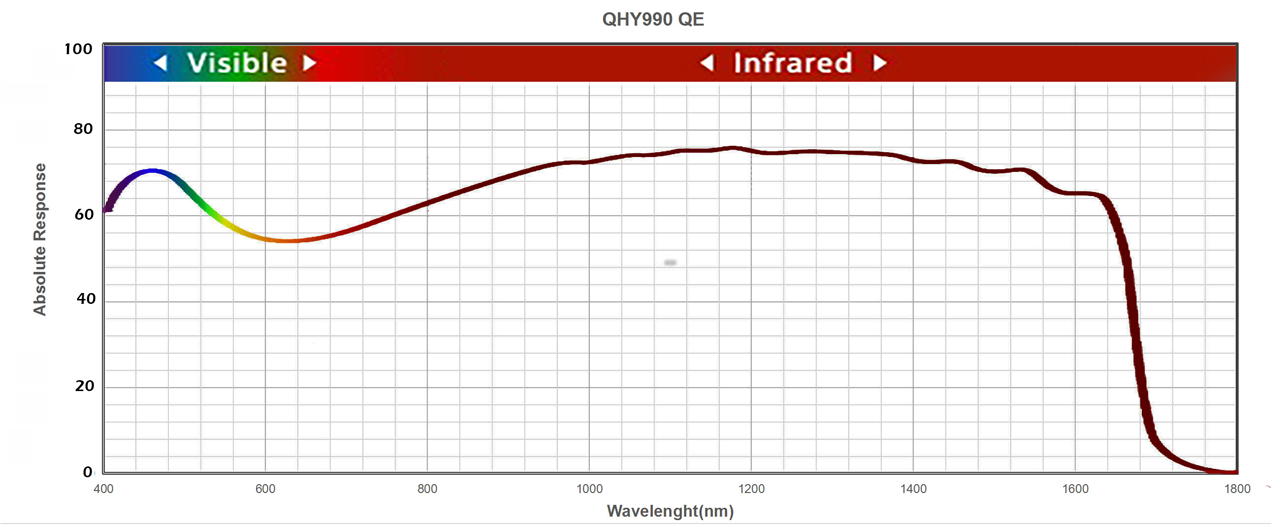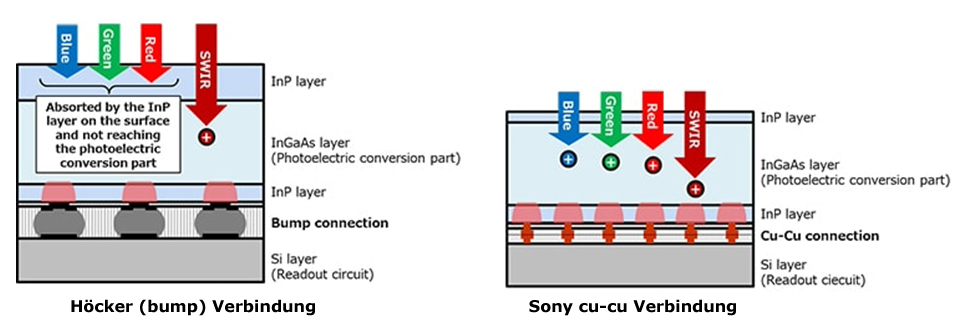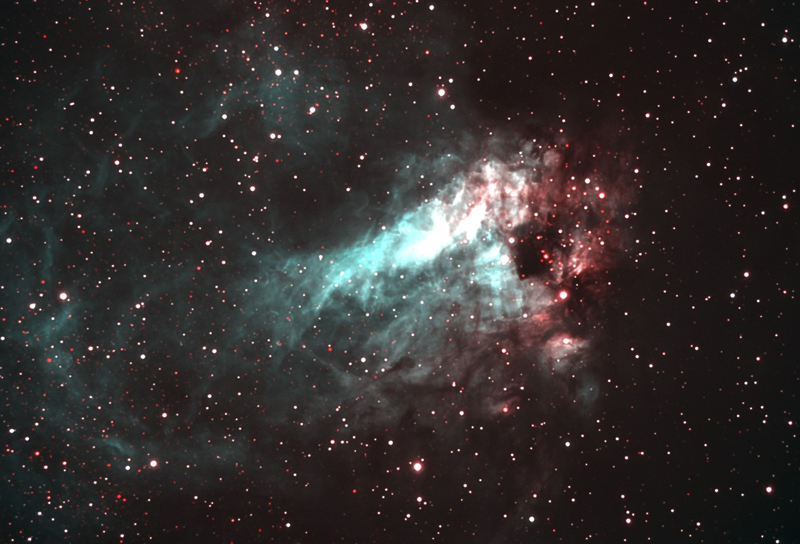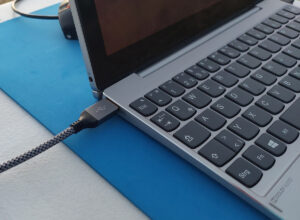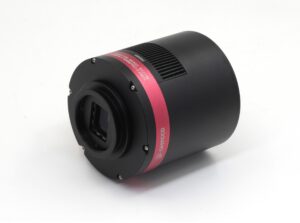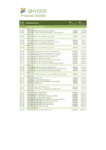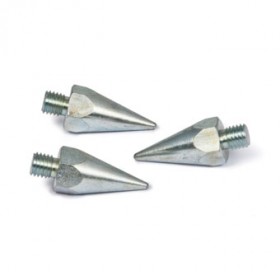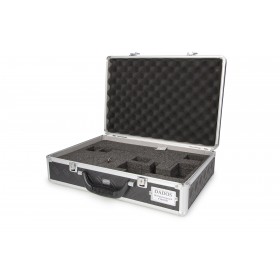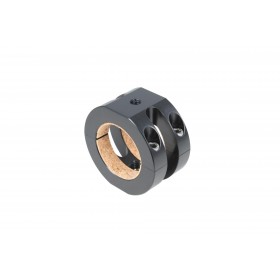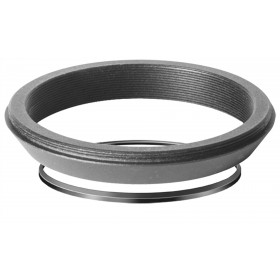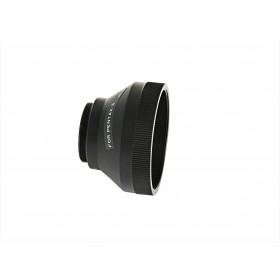Product Questions and Answers
- Description
-
Details
QHY 990 and QHY 991
Shortwave infrared light (SWIR) is usually defined as light with a wavelength between 900- and 1700nm, occasionally also as the spectrum between 700- and 2500 nm. Since silicon sensors have an upper detection limit of about 1000nm, SWIR imaging requires specific optical and electronic components that can process the SWIR spectral range. For SWIR imaging, indium gallium arsenide (InGaAs) sensors are mainly used, which cover the typical SWIR spectrum but also detect wavelengths from 550 nm to 2500 nm. Line sensors based on InGaAs are freely available, but corresponding area sensors are usually ITAR-controlled (ITAR = International Traffic in Arms Regulations, internationale Rüstungskontrolle).
Both the QHY990 and QHY991 have an integrated 25 mm filter holder, a filter size commonly used in laboratory applications. The SWIR filter is easily installed in the camera and with this adapter the camera retains a standard C-mount flange focal length of 17.5 millimetres.
Both the QHY990 and QHY991 are available with either air cooling or liquid cooling. With air cooling, the camera achieves a delta T of 35°C below ambient temperature. With room temperature liquid cooling, a delta T of 45°C below ambient temperature is achieved and with pre-cooled liquid, a delta T of 60°C to 80°C below ambient temperature can be achieved. InGaAs sensors generally have a higher dark current than silicon-based materials. QHY therefore recommends choosing the liquid cooled version for applications that require exposure times of more than a few seconds (e.g. > 5 seconds) or more.
SWIR CMOS Cameras – Tech Talk
- Details on Sony's InGaAs sensors
The new QHY SWIR cameras use Sony's original SenSWIR technology, in which the photodiodes are formed on an indium gallium arsenide (InGaAs) compound semiconductor layer and connected via a so-called Cu-Cu junction to the silicon (Si) layer that forms the readout electronics. This is a technology that enables high sensitivity over a wide range of wavelengths. This breakthrough results in a SWIR image sensor that is compact yet allows seamless image capture over a wide range of wavelengths, from visible to invisible short-wave infrared (wavelength: 0.4μm to 1.7μm). The use of these sensors enables the detection of wavelengths that are invisible to the human eye (approximately from 800 nm), which enables a wide range of applications.
The production of conventional SWIR image sensors is problematic because there are many technical issues to be solved, including further miniaturisation of pixels, increasing the number of pixels, as well as facing various other problems, such as low quantum effectiveness in the visible spectral range and the usual analogue image output.
The new sensors from Sony use a so-called stacking technology with Cu-Cu connection instead of the otherwise usual "bump connection", which Sony has been further developing for years. Cu-Cu technology offers high image quality, a more compact sensor size thanks to miniaturisation, and high sensitivity in a wide range of wavelengths covering both the visible and invisible spectrum. Cu-Cu technology also supports digital image output, which is required in industrial applications today.
- Special features of the Sony sensor design
When connecting the InGaAs layer that forms the light-receiving photodiodes and the Si layer that contains the readout electronics, a certain distance between the connections must be maintained with conventional "bump connection" technology, making it difficult to achieve a smaller pixel size with current industrial CMOS sensors. This made further miniaturisation a serious challenge. However, Sony's new products feature a smaller pixel pitch made possible by the Cu-Cu interconnect, achieving the industry's smallest pixel size of 5 μm. This in turn enables a reduction in camera size while maintaining SXGA (IMX990) or VGA (IMX991. By using Cu-Cu interconnect technology, the sensor has very low FPN noise and pixel defects. Fixed Pattern Noise (FPN)
is a special noise pattern of image sensors that becomes visible at longer exposure times. This spatially determined noise is caused by the different response of the individual pixels to the same illumination intensity.
Image acquisition in both the visible and invisible infrared spectral range.
Sony's SWIR image sensor technology is used to make the upper InP layer, which absorbs visible light, thinner (see also figure Cu-Cu junction above) so that light can be transmitted to the underlying InGaAs layer, enabling high quantum efficiency even in the visible spectral range. Only this technique enables imaging in a broad wavelength range from 400 nm to 1700 nm, allowing the use of a single camera instead of the traditional multiple cameras that were required to capture visible light and near infrared.
SWIR applications in Industry and Astronomy
SWIR imaging is used for a wide range of applications, such as industrial inspection of circuit boards, solar cells and foodstuffs, and also, for example, to detect forgeries of old paintings. You can find more impressive image examples, for example, on this(https://www.edmundoptics.de/knowledge-center/application-notes/imaging/what-is-swir/)
 Information about the surface and the inside of an apple are obtained simultaneously. Left: visible light; Right: short-wave infrared.
Information about the surface and the inside of an apple are obtained simultaneously. Left: visible light; Right: short-wave infrared. Material sorting based on differences in the absorption rates of short-wave infrared light (salt, sugar and potato starch Left: visible light; Right: short-wave infrared
Material sorting based on differences in the absorption rates of short-wave infrared light (salt, sugar and potato starch Left: visible light; Right: short-wave infraredInfrared photography in amateur astronomy
Im spektralen Infrarotbereich liegt unter anderm das Methanband bei einer Wellenlänge von 880 Nanometer. Aufgrund der hohen Quanteneffizienz des Sensors lassen sich zusammen mit dem Baader Methane-Filter 1¼" (889nm, 8nm) (#2458295 , € 239,-) nun auch spektakuläre Bilder der äußeren Gasplaneten mit moderaten Teleskopöffnungen aufnehmen.
In the infrared spectral range, among others, the methane band is at a wavelength of 880 nanometers. Due to the high quantum efficiency of the sensor, together with the Baader Methane-Filter 1¼" (889nm, 8nm) (#2458295 , € 239,-) , spectacular images of the outer gaseous planets can now be taken with moderate telescope apertures.
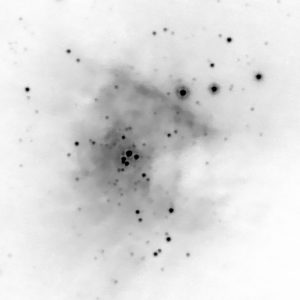 The central region of the Orion nebula in the near infrared (filtered with Schott RG 780 from 800 nm to 1000nm))
The central region of the Orion nebula in the near infrared (filtered with Schott RG 780 from 800 nm to 1000nm))Another field of infrared photography covers DeepSky Lucky Imaging of brighter, very young open star clusters with short exposure times. Their young stars often still "hide" in the surrounding H-II hydrogen nebulae, because the light of the H-II emission often overshines these stars, which glow mainly in near infrared light. The IR band-pass filter blocks the light of the H-alpha emission at 656.28 nanometers and makes the young stars stand out more clearly.
An example in the northern sky is the large open star cluster in the center of the Orion Nebula (see image above), whose stars in the near IR range are also visible to amateur astronomers.
Another example of the possibilities offered by the QHY990/991 is the image of Messier 17, the Omega Nebula. In this example a monochrome image taken in the continuum was combined with an image in the NIR range (800 - 1000nm). The continuum image was coded green and the NIR image was coded red.
All red image details mainly radiate in the infrared spectral range beyond 780 nanometers. Green image details mainly radiate in the continuum. The example clearly shows in which regions of M17 active star formation takes place.
Note on the NIR sample images "Center of the Orion Nebula" and "M17 - the Omega Nebula":
The image of the Orion Nebula and the NIR part of M17 were taken long time ago with a SBIG ST-8 CCD camera. The sensor used at that time was sensitive in the NIR up to about 1100nm, but only with a QE around 10%. They only give examples and suggestions what is "realizable" with the QHY 462C in the NIR range.
In the near IR spectral range it is also possible to "look into" the edges of dark clouds and young stars become visible which remain invisible in the RGB spectral range. Objects for such experiments would be, for example, the dark clouds in the constellation Aquila in the northern sky. In the southern sky there are dozens of interesting objects for both star clusters and dark clouds. The sensor size of 1920 x 1080 pixels at a medium focal lengths is large enough to photograph such objects.
The technical data of the two QHY SWIR cameras in comparison
Model QHY990 QHY991 CMOS Sensor IMX990 SWIR Sensor IMX991 SWIR Sensor FPA Material InGaAs InGaAs Pixel Size 5.0 µm x 5.0 µm 5.0 µm x 5.0 µm Total Pixels 1392 x 1052 (Including optically black pixels) 752 x 520 (Including optically black pixels) Effective Pixel Area 1296 x 1032 656 x 520 Effective Pivels 1.3 Megapixels 0.4 Megapixels Effective Image Area 1/2-inch 1/4-inch AD Sample Depth 12-bit 12-bit Shutter Type Electric Global Shutter Electric Global Shutter QE 77 % at 1200 nm 77 % at 1200 nm Full Well 120ke- typical 120ke- typical Typical Read Noise * Low Gain 150e-, Med Gain 50e-, High Gain 20e- Low Gain 150e-, Med Gain 50e-, High Gain 20e- Frame Rate 66 FPS@Full Resolution 12-bit
137FPS@480 Lines 12-bit
256 FPS@240 Lines 12-bit
518 FPS@100 Lines 12-bit
925 FPS@40 Lines 12-bit
1150 FPS@20 Lines 12-bit133 FPS @ Full resolution 12-bit
254 FPS @ 240 Lines 12-bit
510 FPS @ 100 Lines 12-bit
700 FPS @40 Lines 12-bit
830 FPS @20 Lines 12-bitTrig Function Hardware Trig-In Socket (RCA type). Opto-isolated Hardware Trig-In Socket (RCA type). Opto-isolated Cooling Dual Stage TE Cooler Dual Stage TE Cooler Cooling Performance -35 C° below ambient with air cooling. -45 C° below ambient with room temp liquid cooling and -60C° bis -0C° below ambient with chilled liquid cooling -35 C° below ambient with air cooling. -45 C° below ambient with room temp liquid cooling and -60C° bis -0C° below ambient with chilled liquid cooling Computer Interface USB3.0 USB3.0 Lens Interface C-Mount C-Mount Telescope Interface 1.25-inch Adapter 1.25-inch Adapter Basic Interface Flange with 6-M3 screw holes Flange with 6-M3 screw holes Filter Adapter Supports D=25mm and D=25.4mm filters Supports D=25mm and D=25.4mm filters Back Focal Length C-Mount, 1.25 inch adapter
17.5 mm with filter adapter
14.5 mm without filter adapter
12.5 mm wtih basic interfaceC-Mount, 1.25 inch adapter
17.5 mm with filter adapter
14.5 mm without filter adapter
12.5 mm wtih basic interface* Measured values after bias frame FPN calibration
Performance Characteristics of QHY SWIR cameras
Further detailed information can be found on the QHYCCD webpage
If you have any further questions, please send us an email to kontakt (at) baader-planetarium.de.
Additional Information
| Technical Data not yet specified | Please choose product variant from dropdown above to see technical data of your chosen product |
|---|

